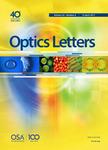版权所有:内蒙古大学图书馆 技术提供:维普资讯• 智图
内蒙古自治区呼和浩特市赛罕区大学西街235号 邮编: 010021

作者机构:Beijing Univ Posts & Telecommun State Key Lab Informat Photon & Opt Commun Beijing 100876 Peoples R China Beijing Univ Posts & Telecommun Sch Elect Engn Beijing 100876 Peoples R China Inst Southwestern Commun Natl Key Lab Secur Commun Chengdu 610041 Peoples R China State Key Lab Cryptol Beijing 100878 Peoples R China Beijing Univ Posts & Telecommun Sch Integrated Circuits Beijing 100876 Peoples R China
出 版 物:《OPTICS LETTERS》 (Opt. Lett.)
年 卷 期:2025年第50卷第4期
页 面:1216-1219页
核心收录:
学科分类:070207[理学-光学] 07[理学] 08[工学] 0803[工学-光学工程] 0702[理学-物理学]
基 金:Fund of State Key Laboratory of Information Photonics and Optical Communications [2023NSFSC0449] IPOC2024ZZ03
主 题:Field programmable gate arrays Optical circuits Optical components Quantum key distribution Random number generation Variable optical attenuators
摘 要:Quantum random number generator (QRNG) allows for the production of truly unpredictable random numbers, thanks to the inherent randomness available in quantum mechanics. However, its practical implementation is facing several challenges, including the practical security loophole, high-speed real-time randomness extraction, and large-scale production. In this work, we address these challenges with a chip-based, source-independent quantum random number generator achieving 20 Gbps real-time generation rate. It ensures the practical security through a source-independent security framework and the modeling of measurement devices. A bandwidth exceeding 2 GHz and a clearance reaching 10 dB is achieved by a silicon- based homodyne detector. Analog-to-digital conversion and randomness extraction are integrated on a single data collection and processing board, where the optimized parallel randomness extraction algorithm on a field programmable gate array achieves a throughput up to 28 Gbps. The results promise a high-speed and practically secure quantum random number generation on a chip, paving the way for its large-scale deployments and widespread applications. (c) 2025 Optica Publishing Group. All rights, including for text and data mining (TDM), Artificial Intelligence (AI) training, and similar technologies, are reserved.